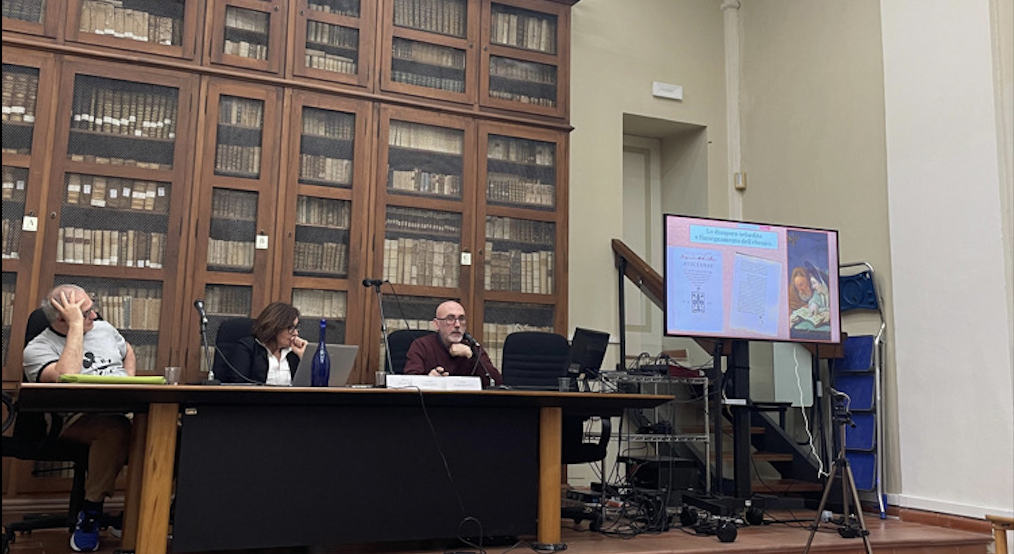The guests of the second and third meetings of the IX cycle of seminars on Adriatic Humanism were Professor Snežana Milinković (University of Belgrade) and Professor Guido Bartolucci (University of Bologna).
The first lecture, held on March 25 and titled Homo Adriaticus. Zuan Polo Liompardi and His Schiavonesque Work, was delivered by Professor Milinković. She presented the figure of Giovan Polo Liompardi, a Venetian jester and poet active in the first half of the sixteenth century. The limited reliable biographical information available derives primarily from contemporary testimonies, which were reviewed during the presentation. Alessandro Caravia, in his poem Il sogno (1541), noted the age at which his friend passed away; Liompardi is also mentioned by Pietro Aretino in a letter addressed to Caravia on March 12, 1542, and in the first Giornata of the Ragionamenti, as well as by Marin Sanudo in his Diarii.
As a “cultural operator” and entertainer engaged in a mixed cultural environment, Liompardi embodied an existential, everyday, and mimetic multilingualism, as he was immersed in a historical context «that thrived on what best represented both the diversity and unity, at the same time, of cultural contradictions and overlaps». His work fits within what Manlio Cortelazzo has defined as “Schiavonesque literature”, consisting of writings in a linguistic blend of Venetian, Paduan, and Florentine, enriched by Slavic lexical and morphological elements.
His book in ottava rima, titled Libero del Rado stixuzo (Venice, Bernardino Vitali, 1533), demonstrates that the role of schiavone assumed by Zuan Polo corresponded to a theatrical mask, revealing the nature of the multilingual-literary play. An analysis of the proem highlights numerous parodic references to Boiardo and Ariosto, as well as several contradictions related to the protagonist, who coincides with the author-performer. The protagonist thus becomes the true subject of the work, while the book itself serves as an additional medium to enhance the author’s voice and performance.
During the second lecture, held on Tuesday, April 1, titled From Galateo to Galatino: The Jewish Tradition and Adriatic Humanism, the speaker presented and analyzed the reception of the Jewish tradition in the Adriatic world, reviewing the most significant authors and works. Starting from 1492, the year in which the Jews were expelled from Spain and sought refuge in cities such as Thessaloniki, Venice, Ancona, and Ragusa, the Adriatic space underwent a transformation, witnessing the movement of Sephardic Jews. With the circulation of ideas, manuscripts, and information, the way in which Christians perceived Judaism changed. Following the rediscovery of Greek patristic apologetic texts, such as Praeparatio Evangelica by Eusebius of Caesarea, humanists began to employ the patristic model to legitimize the use of classical tradition in response to Church criticism, which viewed Humanism as paganizing. At the same time, several anti-Jewish treatises (such as those by Porchetus de Salvaticis and Paul of Burgos) regained circulation. These works were derived from the Pugio Fidei (1265) by Raymond Martini, who argued that in order to convince Jews of the truth of Christianity, it was necessary to study their texts, in which the principles of Christianity were allegedly explained.

Marsilio Ficino and Giovanni Pico della Mirandola engaged with this literature. The former, who had access to a vast and diverse range of sources, including Islamic texts, reutilized the patristic model in De Christiana Religione to develop a new reflection on Christianity. The latter, adopting the Florentine-Ficinian framework, primarily employed Kabbalistic texts translated by Flavius Mithridates in composing his Nine Hundred Conclusiones, where he sought to reconcile different traditions and religions. Regarding Antonio De Ferraris, known as “il Galateo,” his letter De Neofitis (1498) was recalled. Addressed to his friend Belisario Acquaviva, whose son was marrying a woman from a family of converted Jews, the epistle presents an important opportunity to reflect on the role of neophytes within Neapolitan society. Pietro Galatino, who studied Hebrew, drew on numerous Kabbalistic, Talmudic, and anti-Jewish polemical sources in his De Arcanis (1518), in which he aimed to present the hidden truths of Christianity. Meanwhile, Francesco Zorzi employed the Jewish tradition as a means to attain a spiritualized form of Christianity. Finally, among the Jewish intellectuals of the Adriatic world, the printer Girolamo Soncino and Isaac Abravanel were mentioned.
Thank you all for your participation, and see you on May 6.
